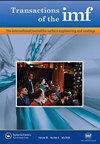硼砂溶液中铝的阳极氧化
IF 1.5
4区 材料科学
Q4 ELECTROCHEMISTRY
Transactions of The Institute of Metal Finishing
Pub Date : 1999-01-01
DOI:10.1080/00202967.1999.11871276
引用次数: 8
摘要
摘要:通过透射电子显微镜观察剥离阳极膜的平面视图和附着在铝衬底上的阳极膜的超微切片,研究了四硼酸二钠中铝上阳极膜的生长,即所谓的碱性阳极氧化。在所选条件下,恒流阳极氧化条件下初始膜生长效率较高;在接下来的恒压期间,多孔阳极膜形成。后者是通过电解质物种渗透到氧化铝膜中而产生的,最终电场聚焦在这些区域,为电场辅助溶解(可能是热增强)建立条件,并形成多孔阳极膜。靠近气孔的细胞壁呈羽毛状,这是高场作用下气孔底部薄膜材料被机械破坏的结果。本文章由计算机程序翻译,如有差异,请以英文原文为准。
Anodizing of aluminium in borax solution
SUMMARYThe growth of anodic films on aluminium in disodium tetraborate, so-called alkaline anodizing, has been examined by transmission electron microscopy of plan views of stripped anodic films and ultramicrotomed sections of the anodic film attached to the aluminium substrate. For the conditions selected, initial film growth proceeds at relatively high efficiency under galvanostatic anodizing conditions; during the following constant voltage period, porous anodic film results. The latter arises through penetration of electrolyte species into the alumina film, with eventual focus of the field in such regions, establishing conditions for field assisted dissolution, probably thermally enhanced, and development of a porous anodic film. The cell walls adjacent to the pores have a feathered appearance, which results from mechanical disruption of the film material at the pore base under the high field.
求助全文
通过发布文献求助,成功后即可免费获取论文全文。
去求助
来源期刊

Transactions of The Institute of Metal Finishing
工程技术-材料科学:膜
CiteScore
3.40
自引率
10.50%
发文量
62
审稿时长
3 months
期刊介绍:
Transactions of the Institute of Metal Finishing provides international peer-reviewed coverage of all aspects of surface finishing and surface engineering, from fundamental research to in-service applications. The coverage is principally concerned with the application of surface engineering and coating technologies to enhance the properties of engineering components and assemblies. These techniques include electroplating and electroless plating and their pre- and post-treatments, thus embracing all cleaning pickling and chemical conversion processes, and also complementary processes such as anodising. Increasingly, other processes are becoming important particularly regarding surface profile, texture, opacity, contact integrity, etc.
 求助内容:
求助内容: 应助结果提醒方式:
应助结果提醒方式:


